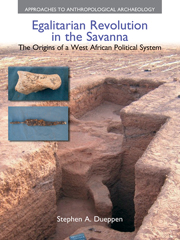Book contents
- Frontmatter
- Dedication
- Contents
- List of Figures
- List of Tables
- Acknowledgments
- 1 Decentralization and the Evolution of Egalitarian Behaviors in Sedentary Societies
- 2 Ancient Villages in the Niger Bend: Context and Methods for Exploring the Voltaic Region
- 3 Ethnographic Perspectives on Western Burkina Faso: A Survey
- 4 Kirikongo: An Introduction to the Site, the Setting, and the Research Design
- 5 The West African Environmental Setting: Kirikongo in Ecological Context
- 6 Stratigraphies and Depositional Episodes: The Excavations
- 7 Relative Chronology: Ceramics
- 8 Community Growth at Kirikongo: The Spatial and Temporal Setting
- 9 Early Sedentary Life in the Voltaic Region: Defining a ‘Voltaic Tradition’
- 10 Craft Production at Kirikongo: The Origins, Development and Reinterpretation of Specialization
- 11 Herding, Farming, and Ritual Sacrifice: The Economy from Kirikongo
- 12 Death and Ritual Objects at Kirikongo: House-Based Social Differentiation
- 13 Archaeological Patterns and Social Process: Reconstructing Changing Life at Kirikongo
- 14 Land, Spiritual Power, and Gerontocracy: An Exploration of the Roots of Egalitarian Revolution in the Western Voltaic Region
- 15 Hierarchy and Egalitarianism within the Niger Bend: Revolution and the Triumph of Communalism
- Bibliography
- Index
15 - Hierarchy and Egalitarianism within the Niger Bend: Revolution and the Triumph of Communalism
- Frontmatter
- Dedication
- Contents
- List of Figures
- List of Tables
- Acknowledgments
- 1 Decentralization and the Evolution of Egalitarian Behaviors in Sedentary Societies
- 2 Ancient Villages in the Niger Bend: Context and Methods for Exploring the Voltaic Region
- 3 Ethnographic Perspectives on Western Burkina Faso: A Survey
- 4 Kirikongo: An Introduction to the Site, the Setting, and the Research Design
- 5 The West African Environmental Setting: Kirikongo in Ecological Context
- 6 Stratigraphies and Depositional Episodes: The Excavations
- 7 Relative Chronology: Ceramics
- 8 Community Growth at Kirikongo: The Spatial and Temporal Setting
- 9 Early Sedentary Life in the Voltaic Region: Defining a ‘Voltaic Tradition’
- 10 Craft Production at Kirikongo: The Origins, Development and Reinterpretation of Specialization
- 11 Herding, Farming, and Ritual Sacrifice: The Economy from Kirikongo
- 12 Death and Ritual Objects at Kirikongo: House-Based Social Differentiation
- 13 Archaeological Patterns and Social Process: Reconstructing Changing Life at Kirikongo
- 14 Land, Spiritual Power, and Gerontocracy: An Exploration of the Roots of Egalitarian Revolution in the Western Voltaic Region
- 15 Hierarchy and Egalitarianism within the Niger Bend: Revolution and the Triumph of Communalism
- Bibliography
- Index
Summary
Dynamic historical trajectories over the past few millennia have contributed to the creation of diverse social formations in the Voltaic region, ranging from vertically organized states to horizontally complex village societies. Interestingly, a common ancestry is attested from at latest the beginning of the first millennium CE, as ceramic data indicate formal and stylistic similarities between sites as far apart as north central Ghana and the Mouhoun Bend in western Burkina Faso (see Chapter 9). Divergence of ceramic attributes occurred throughout the first millennium CE, until in the early second millennium, when two general traditions are identifiable, a southern (currently identified from Ghana) and northern (currently identified in western Burkina Faso). The Mouhoun Bend, at the northern edge of the latter tradition, also borders upon non-Voltaic areas where more extensive archaeological investigations have been undertaken, including the Inland Niger Delta and the Niger Bend. I conclude the book by examining specific events and the general trajectory of our case study within the context of the larger Voltaic setting, with societies in neighboring areas, and, finally, with implications for world-wide theory on the emergence of societies with dispersed arrangements of power and authority.
Innovations in Technology and Economy
The inhabitants of Kirikongo were neither isolated from nor peripheral to developments in greater West Africa, and over the course of occupation excavations attest to technological inventions, early economic adoptions, unique applications of known resources, and overall a great deal of dynamism in this small savanna community.
In addition to subsistence resources available since the Kintampo LSA (cattle, caprines, millet), Kirikongo demonstrates rare evidence of early domestic fonio cultivation and use of shea butter, a vegetal fat of great importance today.
- Type
- Chapter
- Information
- Egalitarian Revolution in the SavannaThe Origins of a West African Political System, pp. 306 - 318Publisher: Acumen PublishingPrint publication year: 2012

